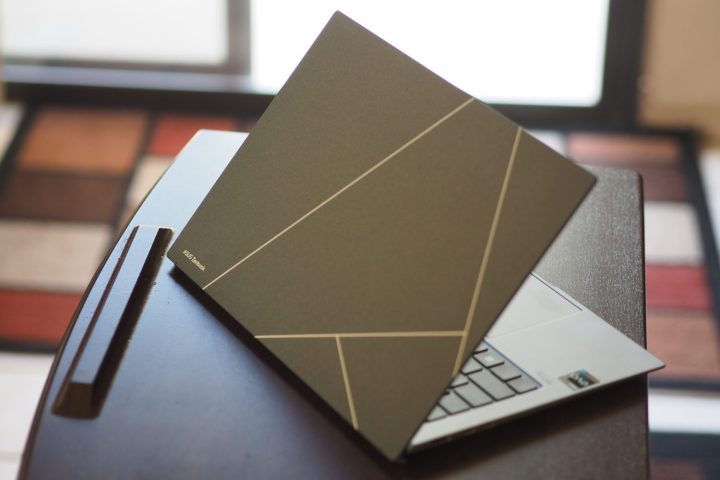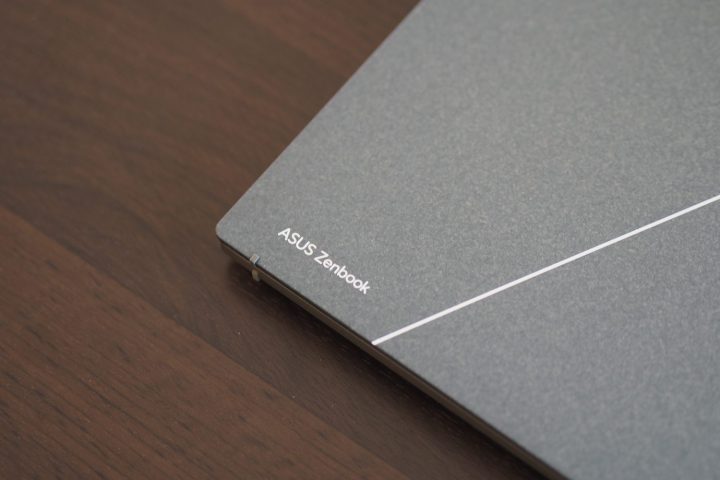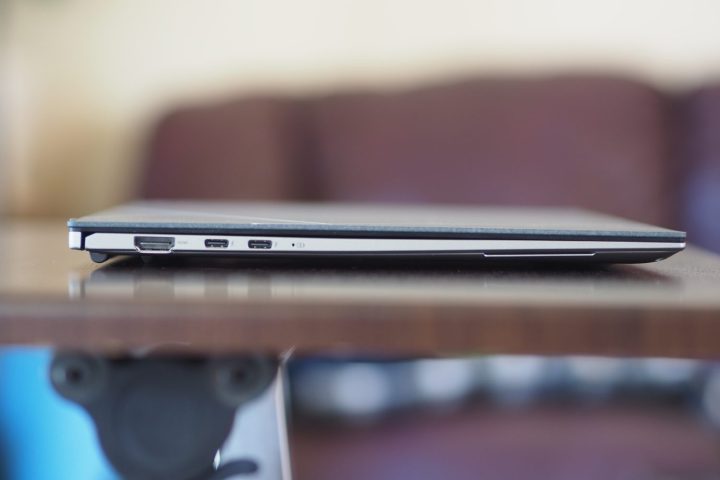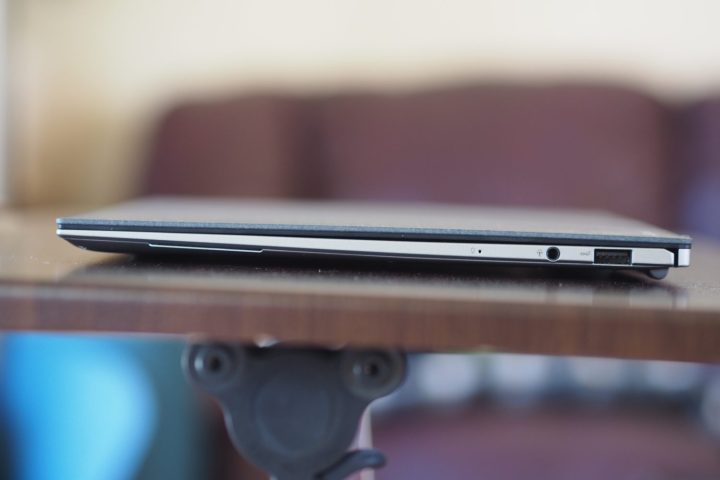- Solid productivity performance
- Above-average battery life
- Attractive and solid design
- Excellent keyboard and touchpad
- Thin and light
- Performance dropped from previous generation
- Speakers are lackluster
The first thing you’ll probably notice about the new Zenbook S 13? It uses a similar black keyboard backdrop as the MacBook Pros. But trust me, there’s more to this laptop than just taking aesthetic inspiration from Apple.
Last year’s Asus Zenbook S 13 OLED was already a solid performer, with a compelling design and outstanding OLED display, and it earned an Editor’s Choice award while barely missing a spot on our best 13-inch laptops list. Aside from the aforementioned design change, the new model also switches from AMD to lower-powered Intel chips. The drop in performance is notable, even if this laptop remains one of the better thin-and-light Windows laptops you can buy.
Specs
| Asus Zenbook S 13 OLED (2023) | |
| Dimensions | 11.66 x 8.51 x 0.43-0.46 inches |
| Weight | 2.2 pounds |
| Processor | Intel Core i7-1355U |
| Graphics | Intel Xe Graphics |
| RAM | Up to 32GB LPDDR5-5200MHz |
| Display | 13.3-inch 16:10 2.8K (2,880 x 1,880) OLED |
| Storage | Up to 1TB PCIe Gen 4 SSD |
| Touch | No |
| Ports | 2 x Thunderbolt 4 ports 1 x USB 3.1 Gen 2 Type A 1 x HDMI 2.1 1 x 3.5mm audio jack |
| Wireless | Wi-Fi 6E and Bluetooth 5.2 |
| Webcam | 1080p + IR camera for Windows 11 Hello |
| Operating system | Windows 11 Pro |
| Battery | 63 watt-hour |
| Price | $1,400 |
Asus currently offers a single Zenbook S 13 OLED configuration, priced at $1,400 for a Core i7-1355U, 32GB of RAM, a 1TB SSD, and a 13.3-inch 16:10 2.8K OLED display. That’s not cheap, but it’s a reasonable price for that much memory and storage. As we’ll see, the laptop offers some features and capabilities that make it a premium contender.
Although I couldn’t find them available online, Asus should be offering cheaper configurations with at least 16GB of RAM and 512GB of storage.
Improving on an already excellent design
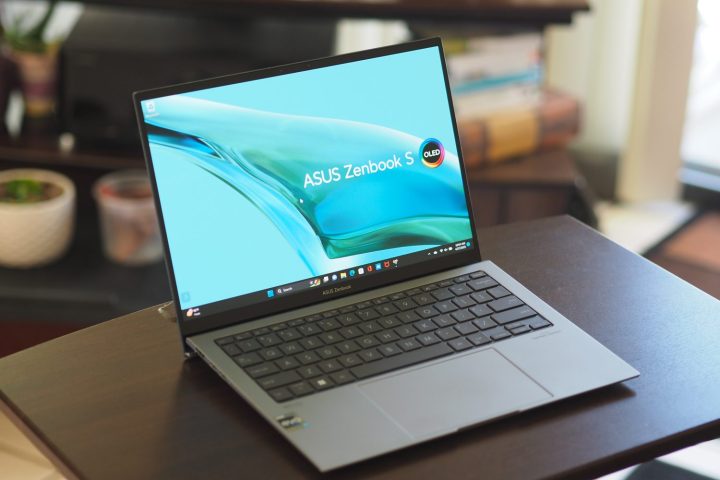
The Zenbook S 13 OLED is narrower at the front (0.43 inches) than the current thinness leader, Apple’s 0.44-inch MacBook Air M2, but it tapers to a slightly thicker 0.46 inches at the rear. Technically, that keeps Apple in the lead. But there’s no doubt that the ZenBook S 13 OLED is among the thinnest laptops. At just 2.2 pounds, the Asus is lighter than the 2.7-pound MacBook Air M2 and among the lightest laptops you can buy. Its display bezels aren’t the smallest, so it’s a bit wider and deeper than some competitors, such as the Dell XPS 13 Plus. Nonetheless, it’s still a tiny laptop that’s easy to carry around.
That light weight is due to a combination of materials used in the Zenbook S 13 OLED’s construction. The attractive chassis is made from a magnesium-aluminum alloy that’s both strong and light. And the lid is a complete departure from past Zenbooks. Gone is the once-iconic Zenbook concentric swirl (which also didn’t make it to the previous model. It’s replaced by a series of lines and a soft matte surface that varies from laptop to laptop and looks great.
That’s thanks to a “plasma ceramic aluminum” material resulting from a process using pure water, temperature, and electricity to create a surface that resembles stone and feels a bit like clay. The result is not only slightly different for each individual laptop, but it’s also strong and 100% recyclable. And sustainability via various recycled materials is a theme with this generation.
While the Zenbook S 13 OLED doesn’t have the dense rigidity of the Dell XPS 13 Plus or the Apple MacBook Air M2, it still feels like a quality laptop. If you try hard enough, the lid will bend a tiny bit, but less than the MacBook Air M2’s. The keyboard deck and chassis bottom are firm.
It’s a great combination of weight and solidity. And remarkably, despite the light chassis, the lid opens easily with one hand, and the hinge holds the display firmly in place. The Zenbook’s typical angled keyboard deck is on hand, with an even more aggressive angle, and it’s comfortable for typing and allows for excellent airflow.
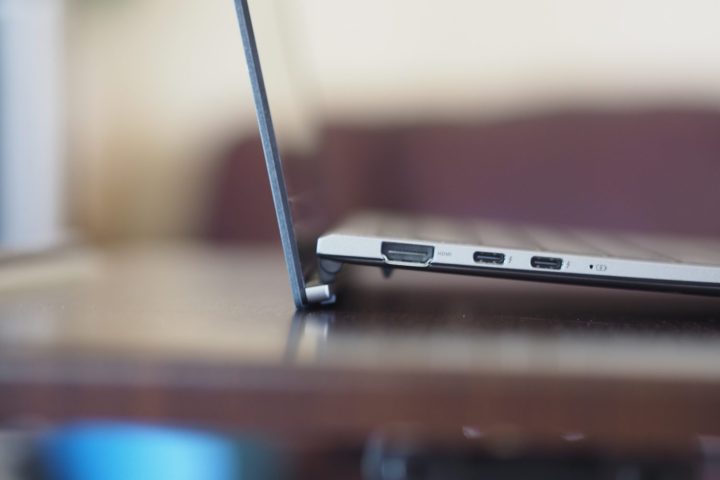
The keyboard has very large keycaps and great spacing, and its switches are light and snappy. It doesn’t quite live up to Apple’s Magic Keyboard, but it’s as good as those on the Dell XPS and HP Spectre lines.
It’s a very comfortable keyboard that fast typists will love. The touchpad is spacious, taking up all the available space on the palm rest, and it has a smooth surface and confident clicks that are just the tiniest bit too loud. But even so, only a great haptic touchpad would be better.

Connectivity is surprisingly strong for such a thin laptop, with Thunderbolt 4, a legacy USB-A port, and even an HDMI 2.1 port. Asus was smart enough to maintain a 3.5mm audio jack where some other manufacturers have started dropping it, and the only glaring omission is an SD card reader. Wi-Fi 6E and Bluetooth 5.2 provide modern wireless connectivity.
The webcam is a 1080p model with various software tools to enhance quality and 3D noise reduction to create a clearer image in low lighting. An infrared camera provides for Windows 11 Hello support. As far as I could tell, there is no user presence-sensing technology, which is becoming more common on modern laptops.
A drop in performance, a jump in efficiency

Asus switched from AMD to Intel in this year’s Zenbook S 13 OLED, and it opted for a low-power CPU as well. Specifically, the 2023 model equips the 15-watt Intel Core i7-1355U, which has 10 cores (two Performance at 5GHz and eight Efficient at 3.7GHz) and 12 threads. Asus pushes the CPU to 20 watts in its performance mode, but as shown in the table below, that didn’t make a huge difference. The new machine is slower than the previous model, at least in CPU-intensive multi-core processes, where the AMD Ryzen was much faster. It’s not clear why Asus didn’t migrate to AMD’s Ryzen 7000 series, but I guess that efficiency mattered more than pure performance this time around.
As it is, the Zenbook S 13 OLED came in second-slowest among our comparison group, only beating out the Dell XPS 13 9315 with its Core i5-1230U. It’s not a slow laptop and will handle fairly demanding productivity workflows. But for anyone else, including creators, it’s not going to keep up. Its 3DMark Time Spy score was also quite low, making it poor gaming laptop even compared to other integrated Intel Iris Xe machines.
| Geekbench 5 (single / multi) |
Handbrake (seconds) |
Cinebench R23 (single / multi) |
PCMark 10 Complete |
|
| Asus Zenbook S 13 OLED 2023 (Core i7-1355U) |
Bal: 1,829 / 6,893 Perf: 1,836 / 6,908 |
Bal: 157 Perf: 135 |
Bal: 1,629 / 6,005 Perf: 1,827 / 6,962 |
5,423 |
| Asus Zenbook S 13 OLED 2022 (Ryzen 7 6800U) |
Bal: 1,417 / 6,854 Perf: 1,404 / 7,223 |
Bal: 114 Perf: 107 |
Bal: 1,402 / 8,682 Perf: 1,409 / 8,860 |
5,647 |
| Lenovo Yoga 9i Gen 8 (Core i7-1360P) |
Bal: 1,843 / 8,814 Perf: 1,835 / 10,008 |
Bal: 122 Perf: 101 |
Bal: 1,846 / 8,779 Perf: 1,906 / 9,849 |
6,102 |
| Dell XPS 13 9315 (Core i5-1230U) |
Bal: 1,393 / 4,459 Perf: 1,477 / 5,350 |
Bal: 333 Perf: 192 |
Bal: 1,379 / 3,457 Perf: N/A |
4,023 |
| Dell XPS 13 Plus (Core i7-1280P) |
Bal: 1,316 / 8,207 Perf: N/A |
Bal: 127 Perf: 94 |
Bal: 1,311 / 6,308 Perf: 1,650 / 7,530 |
4,309 |
| Lenovo Slim 7 14 (Ryzen 7 7735HS) |
Bal: 1,493 / 9021 Perf: 1,498 / 9210 |
Bal: 95 Perf: 84 |
Bal: 1,551 / 12,536 Perf: 1,553 / 13,107 |
6,828 |
| Apple MacBook Air M2 (M2) |
Bal: 1,925 / 8,973 Perf: N/A |
Bal: 151 Perf: N/A |
Bal: 1,600 / 7,938 Perf: N/A |
N/A |
Perhaps battery life is the explanation for the choice of CPU. The Zenbook S 13 OLED did well in our suite of benchmarks, scoring above average in each test with its large 63 watt-hour battery. It couldn’t keep up with the Apple MacBook Air M2, which is a battery life leader, nor the Dell XPS 13 9315, in our web-browsing test, but it beat out the rest of our comparison group. That includes the Lenovo Slim Pro 7 with its 35-watt to 54-watt AMD Ryzen 7 7735HS.
Overall, these are solid results that promise close to all-day battery life. Was it worth dropping performance for a few more hours of battery life? Maybe, at least for the productivity users likely to be most attracted to the laptop.
| Web browsing | Video | PCMark 10 Applications | |
| Asus Zenbook S 13 OLED 2023 (Core i7-1355U) |
9 hours, 47 minutes | 15 hours, 14 minutes | 12 hours, 50 minutes |
| Asus Zenbook S 13 OLED 2022 (Ryzen 7 6800U) |
8 hours, 4 minutes | 13 hours, 13 minutes | N/A |
| Lenovo Slim Pro 7 (AMD Ryzen 7 7735HS) |
9 hours, 40 minutes | 11 hours, 41 minutes | 10 hours, 34 minutes |
| Lenovo Yoga 9i Gen 8 (Core i7-1360P) |
7 hours, 41 minutes | 13 hours, 25 minutes | 9 hours, 40 minutes |
| Dell XPS 13 9315 (Core i5-1230U) |
13 hours, 18 minutes | N/A | N/A |
| Dell XPS 13 Plus (Core i7-1280P) |
8 hours, 0 minutes | 9 hours, 20 minutes | 6 hours, 52 minutes |
| Apple MacBook Air M2 (Apple M2) |
17 hours, 59 minutes | 21 hours, 9 minutes | N/A |
The usual OLED goodness

I’ve yet to review an OLED display that isn’t awesome. The Zenbook S 13 OLED’s version is as good as usual, with bright colors, inky blacks, and enough brightness to work in my usual environments. The only thing I miss is touch, which isn’t an option with the Zenbook.
My colorimeter agreed. While brightness wasn’t the best I’ve seen at 380 nits, that’s more than bright enough for all but working in direct sunlight. Colors were wide (100% of sRGB and 97% of AdobeRGB) and accurate with a Delta-E of 0.78 (well under the 1.0 threshold for demanding creators). As with several recent OLED displays, my colorimeter wouldn’t measure the panel’s contrast, but I’m certain it’s in the usual 25,000:1 range.
In short, the Zenbook S 13 OLED has a beautiful display that will more than meet the needs of productivity workers, creators, and media consumers. Dolby Vision is on hand to ensure excellent high dynamic range (HDR) performance, although the display isn’t bright enough to display HDR as well as Apple’s MacBook Pro laptops with their ultrabright mini-LED displays.
Asus includes a utility to help avoid OLED burn-in, including a pixel-shifting feature, a screensaver, and more. If you’re concerned about avoiding burn-in, Asus has you covered.
Audio was just OK, with decent volume and clear mids and highs. Bass was nonexistent, though, and so you’ll want a pair of headphones or external speakers for anything more than the occasional YouTube video.
Change isn’t always bad
Asus switched up some things with the Zenbook S 13 OLED (2023), reducing performance, but improving efficiency while creating a new and attractive aesthetic. The laptop is different from its predecessor, but the changes make sense and result in an attractive laptop for anyone who wants a highly portable and supremely comfortable laptop.
The $1,400 price is firmly in premium territory, but the luscious OLED display tips the scales in its favor. The Zenbook S 13 OLED 2023 doesn’t quite earn an Editor’s Choice award this time because of the performance drop, but it’s still a great option.


